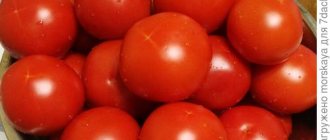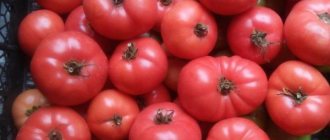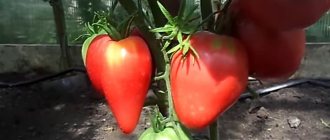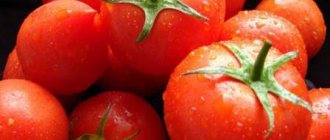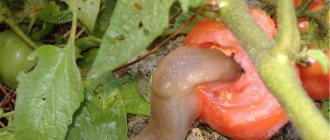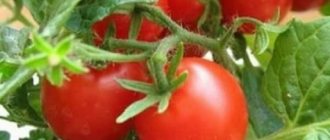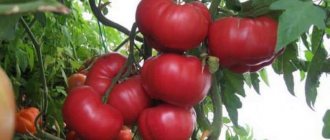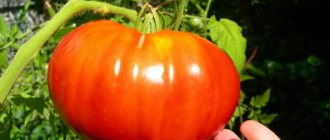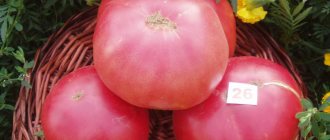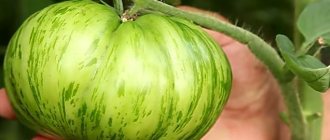Sweet, beautiful tomatoes, reminiscent of an exotic fruit in color and cut, have joined the ranks of unusual varieties. The Kiwi tomato is not inferior in value and abundance to the Malachite Box and Emerald. It has an unusual aroma with pleasant fruity notes.
| Height | Landing location | Ripening time | Fruit color | Fruit size | Origin | Fruit shape |
| Medium height | Greenhouse, Open ground | Mid-season | Greens | Large | Variety | Flat-round |
Description and characteristics of the variety
Kiwi attracts attention not only with its excellent taste and productivity, but also because it is easy to care for the variety. Tomatoes are actively cultivated in greenhouse conditions, greenhouse structures, and open areas. Ripening takes place in the middle period, lasting until autumn frosts.
The collection of the first fruits begins 114-118 days after germination.
Characteristics and features of the variety:
- medium-sized, semi-spreading bushes;
- stem height up to 1.5 m (in greenhouse beds);
- shoot height 0.8-0.9 m (open air);
- semi-determinant growth;
- moderate foliage.
Green tomatoes are good in fresh salads, slices, appetizers, and as an addition to hot side dishes. Used for canning in slices and collecting juice.
What is the attractiveness, description of the fruit:
- weight 200-300 g;
- maximum weight up to 500-600 g;
- emerald coloring;
- the pulp is sweet, moderately juicy;
- taste with fruity notes;
- flattened shape;
- at maturity the flesh is marsh-yellowish;
- The skin is strong and does not crack.
Growing and care
Successful cultivation is possible even in conditions of changeable climate and cool summers. The main requirement is compliance with the basic recommendations of leading agricultural technicians.
Deadlines
Like many other tomatoes, Kiwi is grown by sowing seedlings. It is natural that depending on the climate and location of the region, these periods will change in each individual case. For example, in most regions, sowing for seedlings is carried out in early to mid-March; in particular, for certain areas, March 1-10 is considered the optimal time.
Related article:
Two buckets from each bush or how to achieve high tomato yields
Capacity
Depending on the available capabilities, resources and personal preferences of each gardener, different forms and containers are used for seedlings, both factory-made and those made independently from scrap materials. Most often used:
- boxes made of plastic, wood;
- food packaging;
- disposable plastic cups;
- purchased ready-made forms of various types;
- cassettes with individual cells;
- peat tablets and forms.
The optimal size of such a pot is 10*10 cm.
Regardless of the container chosen, there must be drainage holes at the bottom to prevent rotting of the root system of the sprout.
Planting material
Agronomists and agricultural technology specialists recommend purchasing seeds from trusted manufacturers. Such planting material will ensure high germination and guarantee a good harvest in the future.
Related article:
Why do tomatoes have white streaks inside?
At the same time, experienced gardeners are engaged in independent selection of seeds from fruits grown in their summer cottages for subsequent sowing.
Immediately before sowing, it is necessary to prepare the planting material:
- Pour the seeds onto gauze folded in several layers.
- Wrap and place in a bowl.
- Fill with an activator-growth regulator (for example, “Agat”, “Epin”) - apply according to the instructions for use.
- Leave for 10 hours.
- Remove and place to dry on a sheet of paper towel.
For successful germination, it is necessary to maintain the air temperature in the room with trays within +20-25 degrees Celsius.
Priming
For individual forms, you can use ready-made purchased substrates; consultants in gardening stores will help you choose the right option based on the requirements of the variety. Also, many summer residents practice preparing their own soil mixture, for which it is necessary to take the following ingredients in equal parts:
- peat;
- river sand;
- turf land.
Related article:
Caring for tomatoes in greenhouse conditions
First, sift each of the components, remove weeds, roots and debris. Mix in a deep container and leave for a while.
For an open garden bed, it is recommended to choose a well-lit area of the garden without the shadow of fences and tall trees. Before sowing, dig up with fertilizer, wood ash, compost and manure. It is not advisable to use last year's planting sites where potatoes, eggplants, peppers, physalis or onions were previously grown, since such soil has a high risk of containing late blight.
The optimal predecessor crops are root vegetables, legumes and pumpkins.
Plan ahead: What crops can coexist in the garden
Preference is loamy soil with the mandatory application of organic fertilizers.
Sowing
The main recommendations for carrying out the work are as follows:
- General boxes or containers. Fill the bottom with drainage, then soil, level it, loosen it and pour water on it. Leave until all the liquid is absorbed. Make grooves on the surface at a distance of 3 cm from each other.
Related article:
Tricks for caring for tomatoes
Using tweezers or a stick, carefully spread the seeds to a depth of 1 cm, keeping a distance of 2-3 cm. Sprinkle earth on top (1.0-1.5 cm).
- Individual forms. Fill with drainage and substrate, water, leave for half an hour. Place 2-3 seeds in each mold and sprinkle a little.
Spray warm water with a spray bottle. Cover with film or glass and place in a warm place. Initially, you cannot use window sills, since direct sunlight will cause the hatching seed embryos under the film to die.
Before planting in a permanent bed, seedlings grow in forms for 55-60 days.
Country tricks: Planting tomato seedlings in a snail
Picking
Seedlings sown in boxes require picking - transplanting into larger individual forms. Carrying out this process carefully is extremely important for the subsequent growth and development of the plant.
Related article:
7 most productive tomato varieties for growing in open ground and in greenhouses
The optimal time for such manipulation is the beginning of the formation of the second true leaf after the existing first one (excluding cotyledons). The sprout reaches this state 10-15 days after emergence, however, this feature is quite individual depending on the growing conditions.
The recommended temperature is +18-20 degrees Celsius.
To promote the full development of sprouts in the evening and at night, additional illumination with fluorescent lamps is necessary.
Seedlings, initially planted in forms, upon reaching the recommended period, namely the second ten days of May, are planted immediately on the prepared bed without diving.
Landing in a permanent place
The previously allocated space or soil in the greenhouse must be prepared; planting is carried out in holes according to the 50*50 cm pattern.
Some gardeners practice planting seedlings 2 bushes in each hole. At the same time, it is important to observe the permissible number of plants that will grow per 1 square meter. m - there should be no more than 3 pieces.
Related article:
To make tomatoes turn red quickly
If tomatoes are planted in open soil earlier, for example, in early May, then in their reviews gardeners talk about the need for additional covering with film or spunbond. It is removed when the weather has been persistently warm for several days.
Fruit ovary occurs at an average air temperature of +17 degrees Celsius.
Watering
The vegetable is a drought-resistant crop; excessive soil moisture leads to the death of the plant. Therefore, during the growing season, watering is carried out on particularly hot days.
Fertilizer
Kiwi, like other varieties of tomatoes, needs to be fed periodically. To do this, use ready-made fertilizer complexes, which must be used according to the description and manufacturer’s recommendations on the packaging:
- planting seedlings - 1 tbsp. l. phosphorus-potassium mixture into each well;
- before flowering - nitrogen complexes;
- during the flowering period - “Agricol”, “Kemira”;
- fruit formation – magnesium sulfate;
- maturation - superphosphate, potassium salts.
Related article:
Is it possible to plant tomatoes without picking?
Diseases and pests
To prevent various diseases and prevent the appearance of pests, it is necessary to constantly monitor the general condition of the bushes and the level of soil moisture. When the first signs of disease appear, treatment should be carried out with appropriate preparations, a wide range of which is available in any gardening and horticulture store.
Growing a variety: step-by-step instructions
Let's take a closer look at what you need to do if you decide to grow the Kiwi variety yourself and treat yourself to delicious fruits of unusual color:
- Take a shallow container and fill it with 5 cm of soil.
- Use tweezers to spread the grains in it, the depth is no more than 1.5 cm, leave a distance of about 3 cm.
- Cover with 1 cm of soil.
- Spray with water - the ground needs to be moistened.
- Next, cover the container with film and do not need to open it until new sunrises appear.
- You cannot water the seeds.
The optimal temperature is +20…+25 ºС.
Next, you need to pick - this means that the grown bushes need to be planted in separate containers. During this period, the plant needs to be in a colder climate - +18...+20 ºС. You will also need a lot of light - illuminate the bushes from 16 to 18 hours a day, for this you can use artificial light sources (placed at a distance of about 15 cm).
Feeding is needed - every 10 days. Chicken manure or cow manure will do. As soon as the soil begins to dry out, water the plant. Planting in the ground must be done in a timely manner, since if it is late, there is a possibility that the fruits will ripen until September.
tomato Kmitsits - description and characteristics of the variety
Advantages and disadvantages
Like any other variety, Kiwi has its positive and negative sides. Among the main advantages are:
- high product and taste characteristics;
- uniform germination of crops;
- large fruits;
- resistance to adverse factors;
- uniformity of fruiting;
- Possibility of storing picked unripe tomatoes.
The main disadvantages, according to gardeners, are the following:
- the need to grow in well-lit beds, which is not always possible due to the location of the garden or greenhouse;
- large fruits are not suitable for canning whole;
- short shelf life after removing ripened fruits from the bush due to softening and dents.
Related article:
Tricks for caring for tomatoes
Usually these tomatoes are not used for canning due to their large fruit and softness. However, some housewives practice pickling unripe tomatoes in slices or preparing juices and sauces.
How to grow a tomato
Growing Wonder of the World tomatoes is not much different from other types. Sow seeds for seedlings in April. Then make a dive of the bushes, and soon plant them in a greenhouse or on an open surface. The bushes love the sun, so it is better to plant them on the sunny side. Weeding, loosening, mulching and removing weeds from nearby growing bushes must be done regularly.
Please note! “Wonder of the World” does not belong to a hybrid plant species, so the seed material can be left for next year.
I would like to tell you in more detail about watering the plant with water. The fact is that the bushes love drought and rarely need feeding. A one-time watering for the whole week is more than enough for them. The water should be at a comfortable temperature, preferably warm. To warm it up, leave a bucket of liquid in a sunny place for a day and in the evening, after sunset, water the plants at the roots with it. Try to avoid getting water on the leaves. The situation is worse with rainy weather conditions; due to constantly wet soil, the bushes can reduce the production of tomatoes. In the rain, try to hide the plant under a film, if of course there is such an opportunity. It is best to grow tomatoes in a greenhouse, where they are not afraid of changing weather.
Occasionally treat tomatoes with mineral fertilizers. If you see weak flowering of the bushes, then feed it with a nitrogen substance. Nitrogen must be handled carefully; too much nitrogen can destroy plants. By the way, if flowering is weak, it would not hurt to water the bushes with a mixture of phosphorus, copper and boron. If pollination is poor (especially in greenhouse conditions), it is recommended to shake each bush every evening.
What needs to be done to reap a good harvest?
Beginner gardeners are often concerned about the yield of a variety. The most important thing is to follow all established recommendations:
- When the plant is in the growing season, it is necessary to water only when it is very dry.
- Before planting seedlings, be sure to add the following mixture to the hole: potassium sulfate superphosphate.
- If you plan to grow the variety in greenhouse conditions, you need to form the plant into 1-2 stems, and each stem should have no more than 5 brushes.
- When the fruits begin to form, it is advisable to apply root feeding using magnesium sulfate.
- When the tomatoes begin to ripen, do not forget to remove old leaves.
As you can see, care is quite simple - no special manipulations are needed to achieve a good result. If you follow all the conditions correctly, you will get an excellent harvest of delicious Kiwi tomatoes.
tomato Kosovo - description and characteristics of the variety
Beginner gardeners are often concerned about the demand for the yield of a variety. The most important thing is to follow all established recommendations:
- For an hour, the plant is in the growing season; it needs to be watered only when it is very dry.
- Before planting seedlings, you need to add at least the following mixture to the hole: potassium sulfate superphosphate.
- If you plan to aeroponics a variety in greenhouse conditions, you need to form a plant with 1-2 stems, and each stem should have no more than 5 brushes.
- From time to time, fruits will begin to form; it is advisable to carry out root feeding using magnesium sulfate.
- Soon the tomatoes will begin to ripen, do not forget to remove the old leaves.
As we see, care is quite simple - no special manipulations are needed to achieve a good result. If you adhere to all the conditions correctly, you will get an excellent harvest of delicious Antinidia tomatoes.
